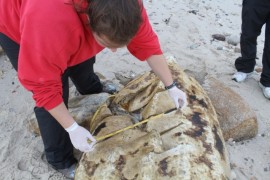The carcass of a leatherback turtle was discovered on a Riverhead beach this weekend.
The leatherback was the victim of a collision with a boat, Riverhead Foundation for Marine Research and Preservation biologist Kim Durham said yesterday morning after foundation volunteers inspected the carcass on the L.I. Sound beach, about a mile east of Roanoke Landing. It has multiple, evenly spaced lacerations across the top of its shell, consistent with a propeller strike, she said.
The carcass was reported to the foundation early yesterday, when the organization got an emailed photo of the carcass from a resident who’d been walking on the beach.
“We had a report of a leatherback carcass on Oct. 19 on a beach near Penny’s Road, east of there, and had received some images on that,” Durham said. “But by the time we got there, it had washed out to sea.”
The carcass reported yesterday looked like the same turtle, judging by both sets of pictures, Durham said. But when foundation volunteers got to it yesterday they were startled to find that it was headless.
“We able to contact the man who sent the photos and learned he actually took them on Saturday,” Durham said. “So sometime between Saturday and today, someone decapitated it and took the skull,” she said yesterday.
“It was definitely cut with a sharp, straight instrument,” she said.
Possession of the skull is a violation of law because the leatherback is an endangered species, Durham said. “You’re not allowed to possess one of these turtles – or any parts – without a permit.”
The foundation reported the incident to the state Department of Environmental Conservation and also to NOAA fisheries, because it is a federally protected species as well.
Unlawful possession of protected wildlife is a misdemeanor in New York, a spokesperson for the NY State DEC said.
“On the federal level this action is a violation of the Endangered Species Act (ESA) which prohibits the possession of endangered species (including parts),” the DEC’s Peter Constantakes said. “Penalties on the federal level may be civil (fine of up to $25,000) and/or criminal (fine of up to $50,000 and/or up to one year of jail time).”
It was a tagged adult female that was more than five feet long and probably weighed 500 to 600 pounds, Durham said.
“She was probably a nesting female,” Durham said. Leatherbacks breed and lay their eggs in warmer climates down south, but migrate to northern waters during summer to forage for food, Durham said. They eat primarily jellyfish. “We’re their buffet table.”
The animal had been tagged in San Juan, Puerto Rico, the foundation learned from its inspection. Durham said she’d written to the researchers who tagged it to inform them of the turtle’s fate and also to ask for additional information about the animal.
The turtle carcass they inspected yesterday was more decomposed than the one photographed on the Northville beach a week earlier, Durham said, so she believes it is the same animal.
“On 10-19 she looked much fresher,” Durham said. “Leatherbacks have a layer of skin over the shell, black skin. On the 19th the skin was still on. Her body cavity was open because of the prop slice and water temperatures, there was an impact on the carcass.”
 The leatherback is the largest turtle — and one of the largest living reptiles — in the world. “When people see one, they think they’ve encountered a sea monster,” Durham said. “In the water, they look like a small island.”
The leatherback is the largest turtle — and one of the largest living reptiles — in the world. “When people see one, they think they’ve encountered a sea monster,” Durham said. “In the water, they look like a small island.”
The biologist said scientists have no clear picture of how many leatherbacks frequent northern waters during the summer months.
“You can only assess numbers with aerial surveys and there’s no money to do that,” Durham said. “We’ve been trying to get funding to do that but so far haven’t been successful.”
Much remains unknown about leatherbacks, she said. “They are long-lived, but we don’t know how long. They become mature at about 12 years old, but we don’t know how long they live after that.”
Durham said she hopes turtles are starting to migrate out of local waters, which are becoming too cold for them to inhabit. Those who stay are at risk of getting cold stunned, she said.
The foundation is getting ready for stranding season, she said.
Anyone who spots a turtle on a beach should immediately call the foundation hotline 631-369-9829, even if it looks dead — as cold stunned turtles do.
The organization is holding a number of training sessions for members of the public. Interested volunteers should contact the foundation here. http://www.riverheadfoundation.org/contact/
The foundation generally transports the turtles back to its hospital inside the L.I. Aquarium in Riverhead and gradually warms them, restoring them to a normal heart rate and body temperature.
“People should not try to warm them up themselves,” Durham said. “They could go into shock and die. It needs to be done very slowly and with IV fluids. Please report them and give us a chance to try to save them.”
The foundation could not remove the carcass from the Riverhead beach because it is too large for them to handle. It notified the town government, which may go down to the beach with heavy equipment to either remove it or bury it.
“Or they may let nature take its course,” she said.
The survival of local journalism depends on your support.
We are a small family-owned operation. You rely on us to stay informed, and we depend on you to make our work possible. Just a few dollars can help us continue to bring this important service to our community.
Support RiverheadLOCAL today.
































